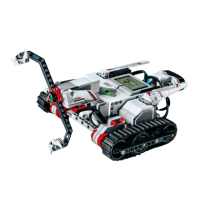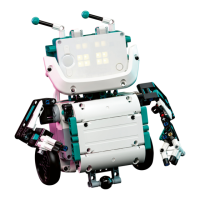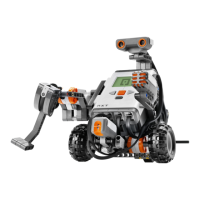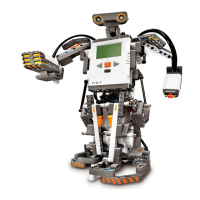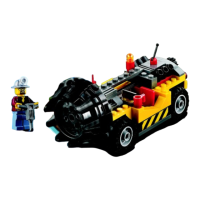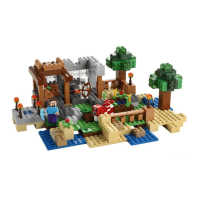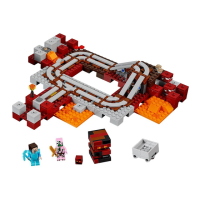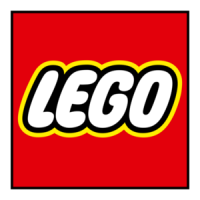
Do you have a question about the LEGO MINDSTORMS Robots and is the answer not in the manual?
| Product Line | LEGO MINDSTORMS |
|---|---|
| Category | Toy |
| Age Range | 10+ |
| Batteries Required | Yes |
| Memory | 64 MB RAM, 16 MB Flash |
| Connectivity | Bluetooth, USB |
| Sensors | Touch, Color, Gyro |
| Battery Type | AA |
| Interactive Features | Programmable, Remote Control |
| App Compatibility | iOS, Android |
| Processor | ARM9 |
| Pieces Count | 601 |
| Battery Count | 6 |
| App Name | LEGO MINDSTORMS EV3 Programmer App |
Defines a robot and its fundamental components: brain, body, actuators, sensors, power source.
Discusses the challenges and types of mobile robots (tethered vs. autonomous).
Explains the MINDSTORMS product line and the Robotics Invention System (RIS) set.
Details the features and components of the RCX, the robot brain.
Describes the components of the RIS software: documentation, programming environment, and downloader.
Discusses programming options for users not on Windows.
Lists official and unofficial websites for MINDSTORMS community and information.
Provides step-by-step instructions for building the Hank robot.
Explains Hank's basic program for exploring and avoiding obstacles.
Discusses different methods of robot locomotion like treads, differential drive, and cars.
Explains the design and function of bumpers for detecting collisions.
Details the purpose and types of LEGO gears used in robot construction.
Explains the RCX's multitasking capability for running multiple tasks simultaneously.
Provides step-by-step instructions for building the Trusty robot.
Discusses the challenges of programming line following behavior.
Explains the concept of robot states for decision-making in programming.
Details how to use and calibrate the light sensor for accurate readings.
Explains the function and importance of idler wheels for robot stability.
Describes how to use two light sensors to simplify line following.
Provides a simple NQC example to get started with programming.
Explains the software layers involved in programming the RCX.
Introduces Not Quite C (NQC) as an alternative to RCX Code.
Details NQC commands for controlling the RCX's outputs (motors, lights).
Explains NQC commands for reading sensor input values.
Covers NQC commands for program control, including waiting, loops, and conditionals.
Explains how to declare and use variables in NQC programming.
Describes NQC commands for playing sounds and music on the RCX.
Details NQC commands for sending and receiving data via the IR port.
Explains how to create and manage a datalog for storing sensor data.
Introduces NQC tasks for organizing programs and multitasking.
Provides step-by-step instructions for building the Minerva robot.
Explains Minerva's basic program for picking up objects and returning.
Describes the mechanical system that allows changing direction of output shafts.
Explains pulleys as an alternative to gears for transmitting motion.
Discusses mechanical challenges in designing Minerva, including the grabber arm.
Addresses the challenge of balancing the robot due to its arm's weight.
Details Minerva's complex drivetrain system for controlling wheel movement.
Explains how to connect multiple sensors to a single RCX input.
Discusses techniques for robot navigation and determining position.
Discusses the availability of Visual Basic (VB) and its versions.
Explains Spirit.ocx as the interface between Windows applications and the RCX.
Shows how to call Spirit.ocx functions directly from Visual Basic code.
Explains the difference between immediate and delayed execution of functions.
Describes how programs, tasks, and subroutines are structured in the RCX.
Offers practical advice on using Spirit.ocx, including retrieving input and timer values.
Details how to extract datalog information from the RCX using Visual Basic.
Lists resources for LEGO Programmable Bricks, robotics, and programming environments.
Provides step-by-step instructions for building the RoboTag robots.
Introduces subsumption architecture as a reactive robot programming paradigm.
Explains the four behaviors (cruise, tag, avoid, tagged) used in RoboTag.
Describes the arbitration task that manages which behavior controls the robot's motors.
Lists resources for RoboTag and subsumption architecture.
Introduces legOS as a powerful, C-based firmware replacement for the RCX.
Details the necessary development tools like cross compilers (egcs) and Cygwin.
Provides a simple legOS program to display "Hello" and verify tool setup.
Describes important legOS functions for display, output, input, and multitasking.
Explains legOS functions for managing the RCX's LCD display with numbers and text.
Details legOS functions for controlling motor direction and speed.
Explains how to read raw input values and configure sensors in legOS.
Describes legOS functions for reading the state of the RCX's front panel buttons.
Explains legOS functions for sending and receiving data via the IR port.
Covers legOS support for multitasking using tasks and functions like execi() and tm_start().
Implements a light-seeking version of Hank using legOS and subsumption architecture.
Discusses methods for physically attaching custom sensors to LEGO bricks.
Describes using wire bricks to connect custom sensors to the RCX.
Explains using copper tubing to create conductive studs for sensor mounting.
Details using machine screws as an alternative to tubing for sensor mounting.
Describes using conductive plates for attaching sensor electronics to RCX inputs.
Introduces passive sensors and their basic circuit diagram for RCX inputs.
Explains how to build a passive light sensor using a photoresistor.
Describes using a thermistor to create a simple temperature sensor.
Explains the concept of powered sensors and the active mode circuit.
Details the circuit for separating power and signal for active sensors.
Explains how to build a touchless touch sensor using a Hall effect sensor.
Describes a circuit for connecting multiple switches to a single RCX input.
Briefly mentions other sensor and actuator possibilities like sound sensors and servos.
Lists vendors for LEGO parts and accessories like sensors and motors.
Provides a table of parts with their item numbers and prices from different sources.
Lists suppliers for electronic components needed for custom sensors.
Summarizes available RCX development environments, languages, and tools.
Lists the necessary software (JDK, Communications API) for the downloader.
Explains how to use the Java-based downloader program to transfer Forth files.
Provides the Java source code for the pbFORTH program downloader.
Mentions the upcoming RIS 1.5 version and its rumored features.
Discusses the RCXJVM project for programming the RCX with Java.
Explores the concept of integrating LEGO robots into a JINI network.
